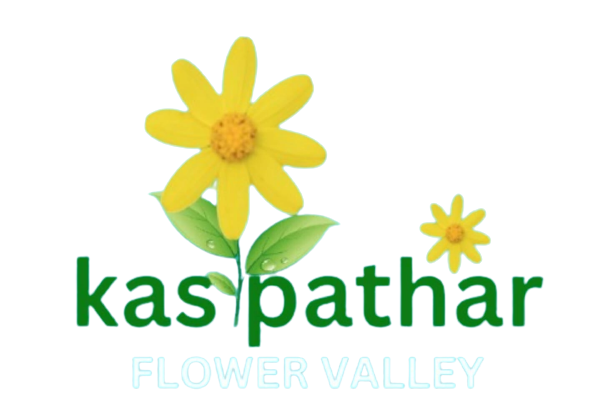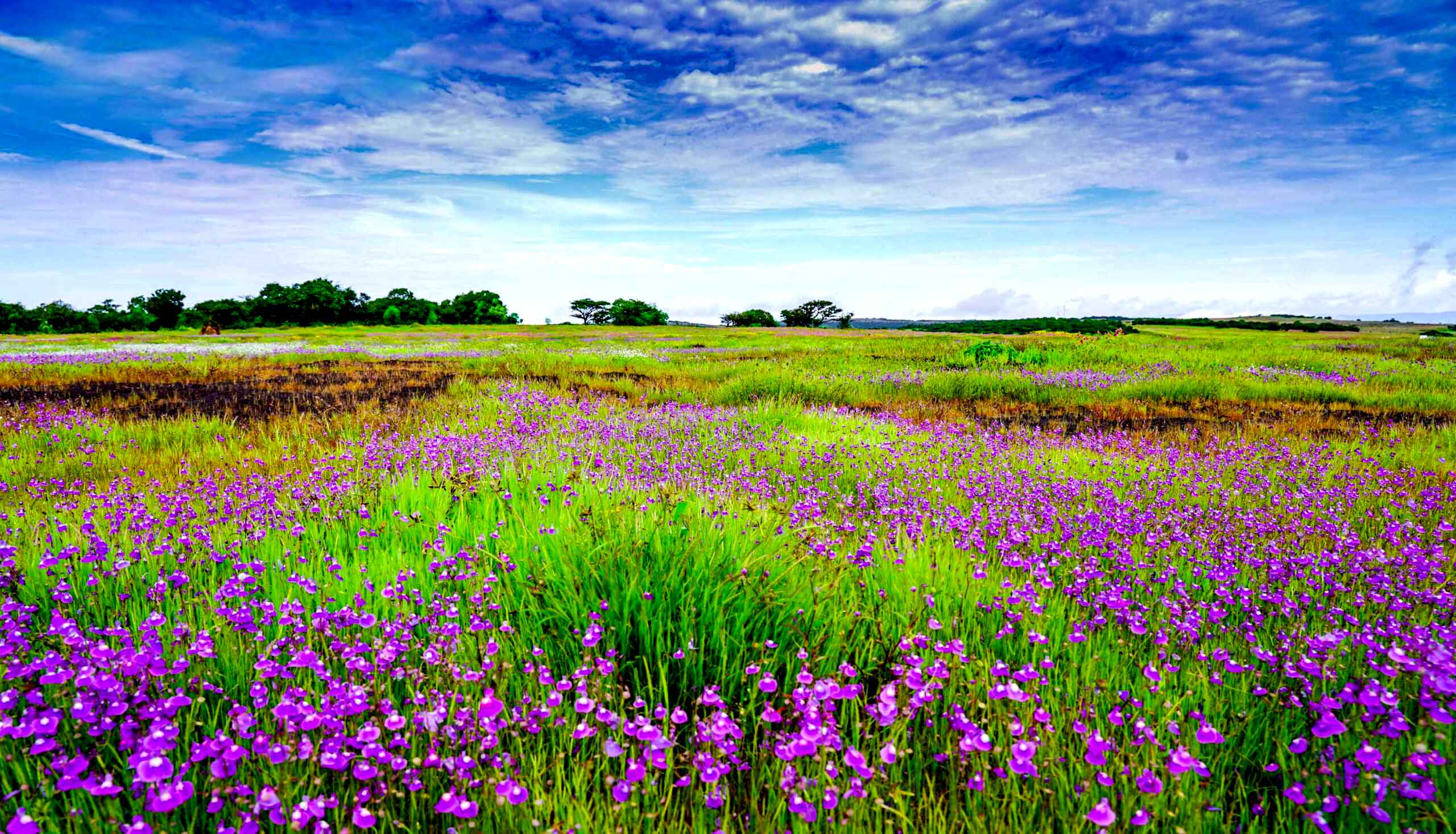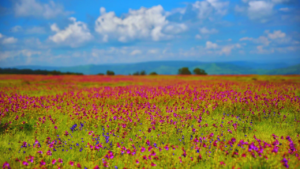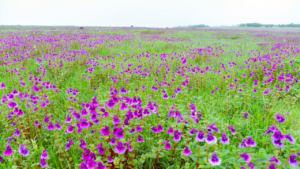A striking natural wonder in South India, you will be mesmerised by its breathtaking beauty, when you visit Kas Pathar. Kas Pathar is a Flower Valley which is known for its captivating charm. In this guide, we’ll delve into the essence of Kas Pathar and make sure you can relish an unforgettable experience, providing you with valuable information to be able to make the most out of your time in this place.
Unveiling the Hidden Gem of Kas Pathar Flower Valley
When looking at the mountain range in Maharashtra, India, Kas Pathar stands out as a breathtakingly beautiful expanse of lush green meadows that, during the monsoon, turns into a kaleidoscopic mosaic of flowers, which is often referred to as the Kaas Plateau of Flowers.
Stretching over 10 square kilometres, Kas Pathar is located in the Satara district, 25 kilometres from the picturesque hill station of Mahabaleshwar and has earned a distinction from the World-famous UNESCO, that named it a World Heritage Site in the year 2012, for its rarity species found here. Geologically formed out of stormy situations, Kas has a very thin layer of soil, which, has made it nearly impossible for any foliage to flourish in the area.
Because the region gets a lot of rainfall, the sorts of plants and creatures you’ll find in this area are rather different from the rest of the world. The unique combination of these characteristics has made Kas one of the planet’s biodiversity hotspots. On this plateau you’ll find over 850 species of flowering plants, out of which 624 have been placed on the IUCN Red List.
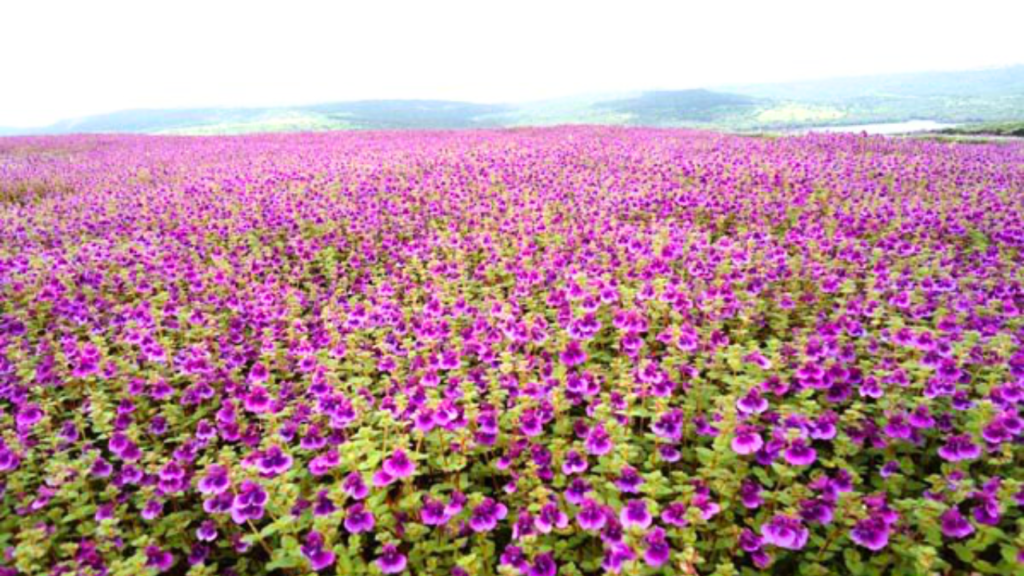
A Symphony of Colours.
Kas Pathar Flower Valley transforms into a breathtakingly beautiful landscape, when the monsoon season arrives. The riot of vibrant colours, the sea of delicate Smithia Hirsuta, the striking Utricularia, and the elegant Impatiens is truly mesmerising and awe-inspiring. The wildflowers that bloom are quite captivating by anyone who would love nature and photography.
The Timeless Appeal of Nature’s Canvas
You’re faced with a mesmerizing sight, and its uniqueness comes from the transformation it undergoes every day, when visiting Kas Pathar. The main attraction of this place lies in its breathtaking scenery that’s ever changing. Just like a fine piece of art, Kas Pathar gets its beauty from the flowers that show up at different times of the year. As the monsoon gets going, one flower after another displays its stunning beauty and in doing so creates a brand-new scene, all over again. Coming from the golden tones of the Crotalaria and the majestic blooms of the blue Dicliptera are two examples of the countless flowers that have and will add to the incredible mosaic of Kas Pathar.
Exploring Kas Pathar: A Journey of Tranquillity
As I think back on the breathtaking scene of Kas Pathar I’m in awe. Coming across the scenic walking paths and burying oneself in the kaleidoscope of colours of the flowers, must be utterly captivating. The soft serenade of the surroundings and the gentle caress of the breeze carrying the sweet fragrance of the blossoms are guaranteed to calm and soothe, essentially creating a reality that is both peaceful and surreal. It’s a place that is said to be perfect for escaping the noise and stress of the world and re-establishing a deep connection with the natural world.

Capturing Memories: Photography Tips and Tricks
As for capturing the essence of Kas Pathar, one of the best times is in the early morning hours or the mesmerizing golden hours of sunset. The soft, warm light that graces the scene at these times highlights the colours and textures of this natural wonder, which is simply magical. Coming well-equipped, make sure to bring a macro lens to capture the microscopic world of the flowers and a wide-angle lens to capture the grandeur of the plateau.
Preserving the Pristine Beauty
As visiting Kas Pathar you’re looking at a delicate ecosystem that needs to be protected. Coming from the government, the Forest Management Committee of the Kaas Plateau oversees the area during the summer months.
Well-known for its rare, endangered and threatened species, which are not found anywhere else, Kas Pathar is a place of beauty that will be available for us to enjoy for years to come and also for our children and grandchildren.
As visitors, it is up to us to ensure the beauty of the plateau remains intact. Please don’t pluck any flowers or disturb the delicate balance of the flora and fauna in any way, let us cherish the incredible natural scenery.
Kas Pathar Season 2024:
Plan Your Visit to Kas Pathar: Practical Information
To make the most of your visit to Kas Pathar, here are some practical tips:
Best time to visit Kas Pathar Flower Valley:
The best time to witness the blooming of flowers is from mid-August to early September, during the peak of the monsoon season.
Timings:-
8 AM to 6 PM
Entry Fee:-
Entry fee: Rs..150/person. If you’ve booked online, it’s important to bring a printed entry ticket as mobile screenshots won’t be accepted (No entry Fee for children below 12 years)
Special facility for school/college students: Rs. 40/person. Letter from the school/college principal is mandatory; without it, the facility won’t be provided. However, this facility is not available on Saturdays and Sundays.
Bicycle Ride: Fee – Rs. 50/- per hour (for travelling from Rajmarg to Kumudini Lake).
Guided Tour: Fee – Rs. 100/- per hour (one guide for ten people)
Online booking is compulsory.
Weather: Pack appropriate clothing and footwear for the monsoon weather, including a raincoat or umbrella.
Accessibility:
When heading to Kas Pathar, where you are coming from will determine what transportation option is best for you, but the nearest big city is Pune, and has excellent connections to the rest of India via air, rail and roads. Once you’re in Pune, Satara is essentially the next stop, where you can rent a car or catch a local bus to get to Kas Pathar, coming from Mumbai, Pune and Satara are also best served by taxis and private cars.
Guided Tours:
When visiting Kas Pathar, join a guided tour to get a deeper understanding of the area’s unique flora, fauna and cultural heritage,
Nearby Attractions:
hen head out to see the nearby Kaas Lake, Ekiv waterfall, Vajrai waterfall, Bamnoli Boat Club, Thoseghar waterfall, Vasota Fort, Ajinkyatara Fort, Sajjangad Fort, Mahabaleshwar, Panchgani and Pratapgad Fort.
Experience the Captivating Beauty of Kas Pathar
In the area, also visit the aforementioned attractions, Kas Lake, Ekiv waterfall, Vajrai waterfall, Bamnoli Boat Club, Thosegharwaterfall, VasotaFort, AjinkyataraFort, Sajjangad Fort, Mahabaleshwar, Panchgani and Pratapgad Fort.
FAQs:-
Which is the best time to visit Kas Pathar?
The best time to visit the Kaas Pathar/Plateau is from mid-August to early October. This plateau is open for visitors from 8:00 A.M. till 6:00 P.M. Online booking is mandatory to visit this plateau.
What is the Kaas Pathar famous for?
Kaas Pathar a Valley of Flowers in Maharashtra, is well known for its massive carpets of blooms that spring at the end of the monsoon season.
What is the entry fee for Kas Pathar?
Entry fee: Rs 150/person. If you’ve booked online, it’s important to bring a printed entry ticket as mobile screenshots won’t be accepted (No entry Fee for children below 12 years)
Special facility for school/college students: Rs. 40/person.
How far is Kas Pathar from Pune?
Pune and Kaas Plateau are separated by 136 miles, and travelling over NH4 takes 2.5 to 3.5 hours.
What is the distance between Mahabaleshwar and Kaas Pathar?
25 km
During monsoon season, from early August until mid-October, the entire grassland transforms into a valley of flowers. In Maharashtra, Kaas is situated around 30 kilometres from Satara and 25 kilometres from Mahabaleshwar. Pune and Kaas Plateau are separated by 136 miles, and travelling over NH4 takes 2.5 to 3.5 hours.
What is the height of Kas Pathar?
1200-1300 meters
Which is the nearest railway station to Kas Pathar?
Satara Railway Station is the nearest railway station to Kaas Plateau.
Which Flower Hill is near Pune?
Kaas Plateau – Maharashtra’s Valley of Flowers – Places near Pune and Mumbai.
How far is Kaas Pathar from Satara?
Kaas Pathar is about 20 km from Satara.
Are there flowers in Kaas Pathar?
It is situated on high hill plateaus and grasslands turn into a ‘valley of flowers’ during monsoon season, particularly from August to early October. Flowers are sensitive to nature. Kaas Plateau has more than 150 or more types of flowers, shrubs, and grasses. The orchids bloom here for 3–4 weeks during this season.
What is the biodiversity of Kas Pathar?
over 850 flowering plants grow on the plateau, including Karvy, Orchids, Smithia Hirsute (Mickey Mouse flower), and many more. Out of them, 39 are exclusive to this region and 33 are listed as endangered by the International Union for Conservation of Nature.
What to be careful about while walking on the Kaas Plateau?
While walking on the Kas plateau, do not go to the edge of the plateau. There is a possibility of rock falling in thick fog. Be careful of snake bites. Keep a distance from wild animals like Bison, and leopards on the plateau.
What is the Speciality of the Kaas Plateau?
Kaas Plateau is a plateau near Satara. It is listed as a World Heritage Site (WHS) by UNESCO. The Kaas Plateau is a laterite soil tableland, typical of the Western Ghats in Maharashtra. During the monsoons, the region known as Kaas Pathar transforms into a wildflower wonderland.
What animals are in Kas Pathar?
Along with the company of nature, there is also the sighting of wild animals. Sheep and rabbits are seen running in the distance. Ferocious animals like leopards, bears, Indian bison, and Sambar deer also come to the plateau. and rare birds like the Woodpecker and the Asian Fairy Bluebird can be found here.
Is Kaas Plateau World Heritage?
When the monsoons begin on the Kaas plateau, numerous types of wildflowers bloom. The plateau was included in the protected list of UNESCO World Heritage Sites in 2012 due to the many rare species found here. It is now become a tourist destination. The government has taken several steps to control the possible damage by tourists.
Which plateau is called the Valley of Flowers of Maharashtra?
Kaas Plateau
Known as the Valley of Flowers of Maharashtra, Kas Plateau is one of the most scenic spots in Satara. It is a great sightseeing spot for people living in cities like Mumbai and Pune.
How do I reach Kaas Pathar from Mumbai?
The nearest major city is Pune, which is well-connected to major Indian cities via air, rail, and road networks. From Pune, Satara will be the second stage of the journey. From Satara, you can hire a private cab or take a local bus to reach Kas Pathar. Taxis or private vehicles are the recommended modes of transportation from Mumbai, Pune, and Satara.
How many types of flowers are there in Kas Pathar?
The entire area is covered with flowers of different colours. Kas has more than 450 species of flowers and some carnivorous plants like the sun. Some flowers come only after a certain year.
Where is Kaas Plateau located?
Kas Pathar or Kas Pathar (local name) is located in the Satara district of Maharashtra. Satara is about 140 km from the main city of Pune. Kas Plateau is a beautiful bio-diversity site located on the hilltops of the Sahyadri in the Western Ghats.
Which flower is rare in Pune?
Karvi flower (Strobilanthes callosa) is a rare shrub found on the west coast of India, mainly in the low hills of the Western Ghats. In Marathi and other local dialects as well as in neighboring Karnataka, the shrub is locally known as Karvi
What are the other attractions in the Kas area that are less than 25 km to 30 km?
Ekive Waterfalls, Bhambavli Vajrai Waterfalls, Kas Lake, Kumudani Lake, Ghatai Devi Temple, Bamnoli Boating Club, Yawateshwar Temple, Vasota Fort, Ajinkyatara Fort, Sajjangad, Thoseghar waterfalls, Mahabaleshwar, Panchgani Pratapgad fort.
What precautions should visitors take to preserve the natural beauty of Kas Pathar?
Do not act in such a way that the flowers will be trampled.
Do not throw garbage elsewhere.
Follow the rules of the Forest Management Committee.
Facebook Page:- https://www.facebook.com/kaspatharflowervalleysatara
Website Link:- https://kaspatharflowervalley.com/ekiv-waterfall/
Read this also:https://www.kas.ind.in/
